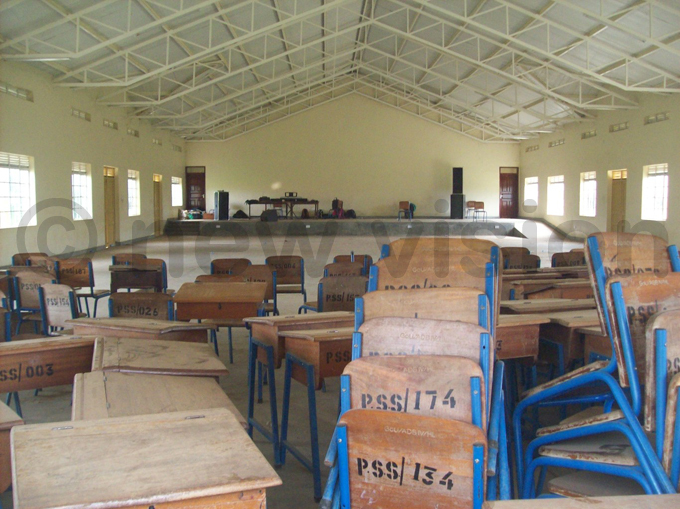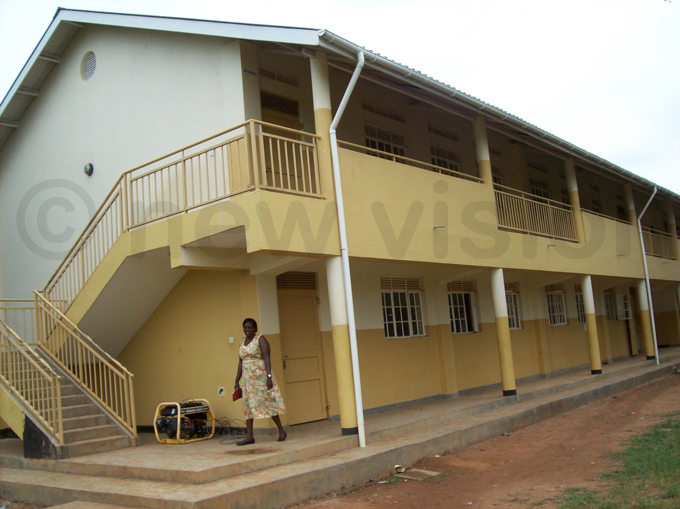Pallisa SS gets new look
Apr 13, 2016
The old administration block still stands majestically right in front of the gate

Almost 2.5km from the urban centre, a murram route branches off the main Pallisa-Agule road leading to Pallisa SS.
The school signpost stands out conspicuously above the roadside bushes in Paucho parish of Pallisa town council. It does not only guide visitors as to what direction to take but also indicates that there is more 200metres to cover.
At the main gate of this mixed O' and A' level school, an askari sits under an acacia tree, noting down details on those entering the compound.
Rows of young pine vegetation dot the southern end of the compound. In between the trees are cassava plants at several stages of growth.
An archaic tiled classroom building is to the left side of the gate. A number of gaps exist on the rooftop, where old clay tiles have fallen off. Termite-infested wooden shutters hang precariously from some window spaces.
The unmistaken smell of bat excreta emanates from the olden block, a constant remainder of the only living occupants of the edifice.
The old administration block still stands majestically right in front of the gate. Its faded green-coloured iron sheets contrast rather sharply with similar roofing materials on the new administration building nearby.
 The first classroom block built in 1956 at Pallisa SS.
The first classroom block built in 1956 at Pallisa SS.
 The new 501 seater main hall.
The new 501 seater main hall.
According to Antonia Iperu, the deputy head teacher, the new office block was acquired in 2013 under a US$ 1.2m Africa Development Bank (ADB) project.
"The one-year project was contracted to Prisma Construction Company. Civil works kicked off in 2012 and got completed a year later," Iperu narrates.
She identifies structures set up under the project as the administration block, laboratory, semi-detached staff house, toilets, eight-classroom double storied block and 501 seater main hall.
Background of the school
Rev. Fr. Moses Kisaka, the Board of Governors (BOG) chief explains that Pallisa S.S. is a Catholic Church founded school that started in 1957 as a junior school up to 1959.
"By then its main purpose was to take in P.6 leavers since P.7 level was non-existent at the time," Kisaka says.
He adds that in 1959, parents in the area took over management operating it as a private school. By 1982, it had a total population of 42 students from S1 to S4.
"In 1983, the school that sits on a 13acre piece of land became a government-aided mixed day school. The only such school located in Pallisa town council up to date," he reveals.
Current status
Sammy Okino, the head master puts the school population at 1, 374 attended to by 37 teachers on government payroll.
 Villagers draw water from communal source set up last year at the school.
Villagers draw water from communal source set up last year at the school.
 The new eight-classroom block.
The new eight-classroom block.
"There are also 18 teachers taken on under BOG arrangement to help out in areas with inadequate staff. The school has seven non-teaching staff and 10 group employees," he says.
Iperu adds that the new main hall has helped accommodate students during the weekly assembly hitherto held under the mango tree adjacent to the kitchen.
"Under the ADB project, the school got 30 brand new computers now installed in the ICT lab. This together with the old stock gives us over 80 sets on location," she adds.
According to her, parents had through the Parents Teachers Association (PTA) attempted to construct a library and science laboratory block in 2008.
"Unfortunately PTA only managed to roof the blocks which prompted intervention. The library was completed in 2011 by Episcop-US while the incomplete science lab now serves as classroom block," Ipenu says.
She reveals that the ADB project enabled the school to get furniture as all the new blocks where fully furnished.
"A new water tank complete with pump was constructed under ABD arrangement. The water is now used to run the toilet facilities as well as supplying the local community in Paucho village," she says.
Martin Nagalira, the second deputy head teacher explains that as a Day-school, learners are meant to be provided with a lunch meal to enable effective attendance of afternoon lessons.
"The school kitchen workers prepare the lunch meal for only those who have paid up. They have meal cards to use in accessing meals," Nagalira observes.
 The ICT lab at Pallisa SS.
The ICT lab at Pallisa SS.
 The Pallisa SS compound.
The Pallisa SS compound.
Academic performance at the school has been comparatively low over the years with most learners at UCE passing in Division 2.
Iperu explains that in 2015, the number of candidates who sat for O' level examinations and awaiting results are 282.
"Whereas 311 were registered for UCE in 2014 only two passed in Division I. Out of the 296 who sat for O' level in 2013 only five garnered division I grades," she affirms.
According to her those who appeared for A' level examinations in 2015 are 118, a much lower number compared to the 214 who registered in 2014.
"The 2014 class had 27 of them scoring three principle passes while another 41 got only 2 principles. Many of them joined tertiary institutes to further their education," she adds.
Challenges
Population of learners keeps fluctuating as students keep shifting from one school to another especially when they don't want to meet school dues like of uniform and lunch pay.
"The ICT laboratory is an improvised room on the eight classroom block. It would have been better if we had a special structure set up for this purpose," Iperu laments.
Nagalira observes that students whose parents can't foot the lunch fee end up missing afternoon lessons.
 The new school main hall.
The new school main hall.
"They claim to be leaving school premises to look for something to eat but many fail to resurface in time for lessons," he adds.
What others say
Isaac Odwol (ICT teacher)
The school now has more spacious study rooms and the learners are benefiting. Those who stay in the vicinity even attend night preps at the school premises nowadays.
Salume Akol (resident)
I am happy the only public secondary school in the neighbourhood has been given a facelift. These nice buildings would definitely make our students perform better in the near future.
Samalie Akite (school cook)
The ADB project has benefitted the local community through provision of safe water. We used to look for water from unsafe sources until this communal tap was constructed last year.
John Michael Omuron (member of school board)
The new buildings are a God-sent opportunity to us. The only thing remaining is to have more teachers on government payroll to stop local recruitment of teachers as the move burdens parents financially.
